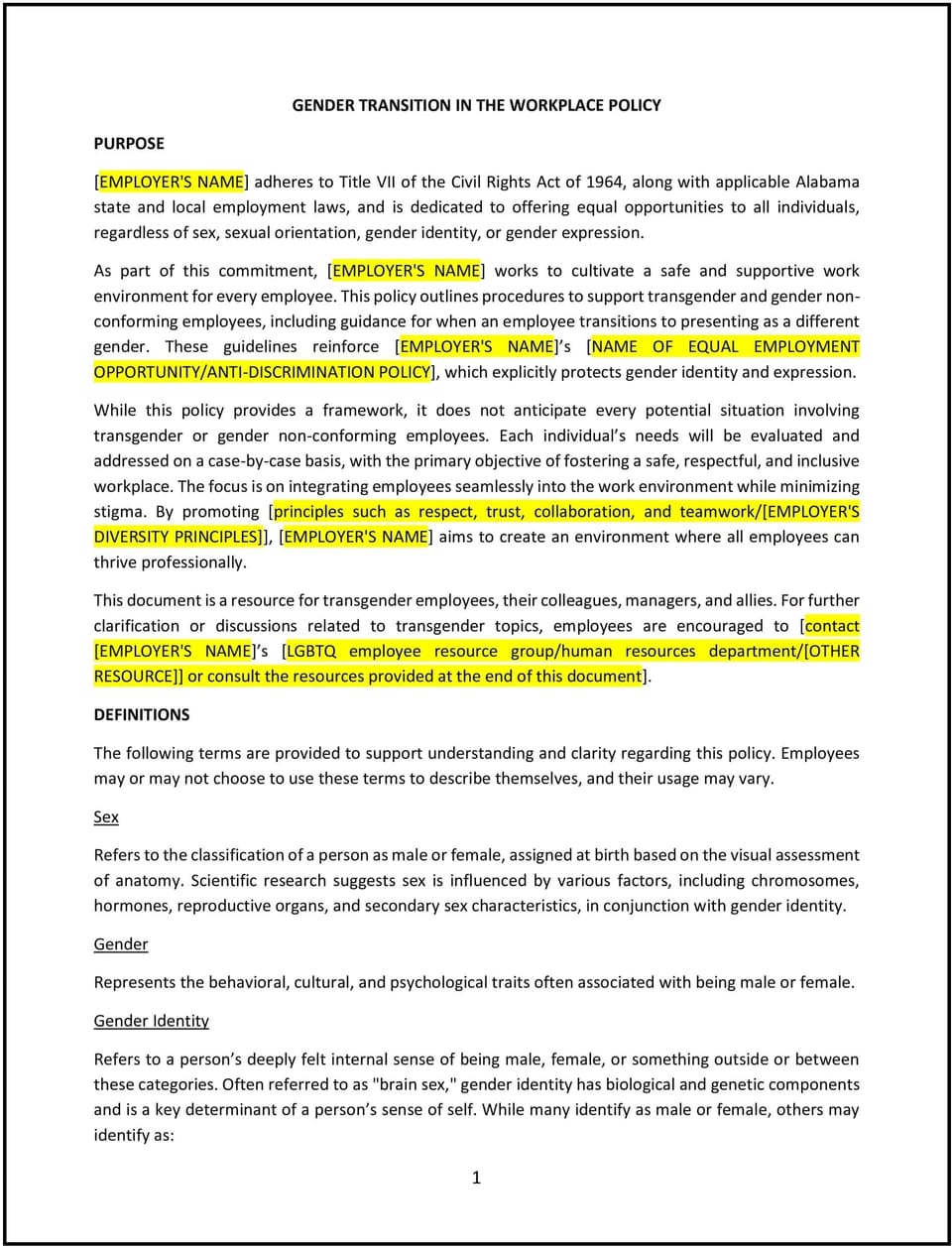Gender transition in the workplace policy (Alabama): Free template

Gender transition in the workplace policy (Alabama)
A gender transition in the workplace policy establishes guidelines for supporting employees undergoing a gender transition, ensuring a respectful and inclusive environment. For SMBs in Alabama, this policy helps foster a workplace where all employees feel valued and supported while providing clarity on rights, responsibilities, and accommodations during the transition process.
By tailoring this policy to your organization, you can create a framework that aligns with your company’s values, encourages diversity, and helps meet applicable workplace standards.
How to use this gender transition in the workplace policy (Alabama)
- Define the scope of the policy: Clearly state that the policy applies to all employees and includes guidelines for transitioning employees, coworkers, and management.
- Establish confidentiality practices: Emphasize the importance of protecting the employee’s privacy and outline procedures for managing sensitive information.
- Address communication: Provide guidance on how employees can communicate their transition plans to management, HR, or coworkers, ensuring a supportive and respectful process.
- Include accommodations: Specify potential accommodations, such as updating names and pronouns in company records, providing access to gender-neutral facilities, and addressing uniform or dress code considerations.
- Outline training and education: Incorporate training for employees and managers on topics like gender identity, inclusion, and respectful workplace interactions.
Benefits of using a gender transition in the workplace policy (Alabama)
A gender transition policy offers significant benefits for your business and employees. Here’s how it helps:
- Fosters inclusivity: Demonstrates your commitment to diversity and inclusion by supporting employees during a pivotal life event.
- Builds trust: Shows transitioning employees that their workplace values and respects their identity, promoting loyalty and morale.
- Enhances workplace culture: Encourages respectful interactions and collaboration, creating a more cohesive and supportive team environment.
- Reduces misunderstandings: Provides clear guidelines for employees and management, minimizing potential conflicts or confusion.
- Attracts diverse talent: Positions your company as an inclusive and progressive employer, appealing to a broader range of candidates.
Tips for implementing a gender transition in the workplace policy (Alabama)
- Develop an individualized plan: Work with transitioning employees to create a tailored plan that addresses their specific needs and workplace adjustments.
- Update company systems: Ensure systems like payroll, email, and personnel records can accommodate name and gender changes.
- Provide ongoing support: Offer access to HR, employee assistance programs (EAPs), or other resources to help employees navigate the transition process.
- Create inclusive facilities: Where possible, provide access to gender-neutral restrooms and changing facilities to support transitioning employees.
- Encourage open dialogue: Foster a culture where employees feel comfortable discussing their needs and asking questions in a respectful manner.
Q: What is a gender transition?
A: A gender transition involves an individual aligning their gender presentation or identity with their true gender, which may include social, legal, or medical steps.
Q: How can an employee communicate their transition to management?
A: Employees can inform HR or their direct supervisor, who will work with them to create a supportive plan and ensure confidentiality.
Q: Are coworkers required to use an employee’s chosen name and pronouns?
A: Yes, coworkers should respect and use the transitioning employee’s chosen name and pronouns as part of fostering an inclusive workplace.
Q: What accommodations are typically provided during a gender transition?
A: Accommodations may include updating employee records, adjusting uniforms or dress codes, providing access to inclusive facilities, and offering flexible schedules for medical appointments.
Q: How can managers support a transitioning employee?
A: Managers can provide support by maintaining open communication, respecting privacy, and ensuring team members follow the policy’s guidelines.
Q: Is training required for employees and management?
A: While not mandatory, providing training on gender identity and inclusivity can help create a more supportive and respectful workplace culture.
This article contains general legal information and does not contain legal advice. Cobrief is not a law firm or a substitute for an attorney or law firm. The law is complex and changes often. For legal advice, please ask a lawyer.


